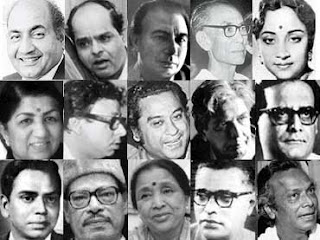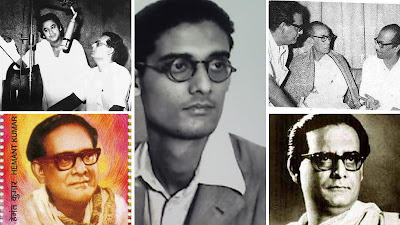PART 2 OF 10: THE CHITALKAR MAGIC
I picked the timeframe 1950 – 1975 for a reason. For one, the extremities were nice, round multiples of five. But then there are real reasons. Throughout this series, I will be name-dropping abundantly and almost all of stalwarts either made their debut or made it big in 1950 and the thereabouts. This was no mere coincidence.
So, what happened in 1950 that actuated that change? Don't get me wrong. The Hindi film industry was like Ranganathan Street even in the forties. It was a bustling, vibrant place. In fact, Bombay made more movies per year between 1945 – 49 than between 1950 – 1960. So, it was not like the sleepy forties suddenly woke up and started manufacturing talent out of thin air. But 1950 symbolized a generational shift in the musical talent of the Hindi industry. The music composers that ruled the nineteen forties were names like Bulo Rani, C. Ramachandra, Husnlal Bhagatram, Khemchandra Prakash (who can forget 'Aayega aanewala'?), and Chitragupta. Stalwarts, no doubt. But the next gen of musicians and the creative forces behind them - the directors, the actors, lyricists, et al - that were waiting to burst into the scene, chose to do so around 1950 and ushered in the Golden Age in absolute style. Who are we talking about?
Naushad and SD Burman, two of the biggest composers of this era, who had not established themselves as yet, will do so in the early fifties. Shankar-Jaikishan, who would end up becoming the most prolific music director duo for the next quarter century made their debut in 1949 with 'Barsaat'. Madan Mohan and Roshan made their debut in 1950. Salil Chowdhury made his debut in Bengali in 1949 and in Hindi with 'Do Bigha Zameen' in 1953. Jaidev and Ravi made their debut in 1955.
The great Hindi/Urdu writers of that era - Majrooh Sultanpuri, Hasrat Jaipuri, Shailendra, Shakeel Badayuni, Sahir Ludhianvi, and so on - had just started to descend onto Bombay and flowered to their best faculties in the early fifties.
What about the singers? Asha Bhosle sang her first Hindi solo in 1949. Lata and Rafi were already top talents but they would leave their predecessors such as Noor Jehan, Saigal, Shamshud Begum, and Talat Mehmood behind once they started associating with the great composers of the fifties. It was not just musical talent that was churning and re-consolidating around the fresh young talents. Every aspect of the Bombay creative industry was receiving a fresh lease of life.The era of the leading men of the forties - Ashok Kumar, Motilal, and KL Saigal - was coming to an end. The Big Three heroes – Raj Kapoor, Dilip Kumar, and Dev Anand – started to come off age in 1950 and after. Raj became an international star with 'Awara' in 1951 although he had a big hit in 'Barsaat' in 1949. He followed it up with 'Aah', 'Shree 420', 'Anari', and a string of highly successful movies. Dilip Kumar was arguably the biggest leading man, with back to back hits in 1950: 'Babul', 'Jogan', and 'Arzoo'. Dev Anand had 'Baazi', 'Jaal', 'Humsafar', 'Taxi Driver', and 'CID'.
So, 1950 is when the celestial stars were beginning to align perfectly to spawn a quarter century of path-breaking music and cinema.
Let me start by paying obeisance to an eminent composer and a trendsetter in Indian music: C Ramachandra (Ramachandra Chitalkar), as a way of doffing my hat to that previous era. As far as the Hindi and Marathi music scene of the forties went, Mr. Chitalkar was the undisputed king. His name reached far and wide, like Gopal tooth powder, and he had great successes even in the South.
The all-time Tamil mega hit, 'Kannum kannum kalanthu', which featured a legendary dance duel between Vyjayanthi Mala and Padmini, was a C. Ramachandra composition. His music had an Indianness to it, and yet had a subtle blues and a western lilt. He was the inventor of scatting and wordless vocables in Hindi, evident from his songs: 'Meri jaan meri jaan Sunday ke Sunday', 'Shin shinaki boobla boo', and 'Ina mina dika'.The year was 1953. India’s infantile democracy was barely crawling, recovering from two-hundred years of colonialism, the partition, full-fledged wars and occasional skirmishes. Indian Airlines was just established. The first Soviet-style, Five-year plan had been rolled out. There was tumult in the South with Andhra being carved out of Madras Presidency, making it the first state in independent India split on a linguistic basis, which would result in the States Reorganization Act of 1956.
The Bombay and the regional film industries were thriving, as it always had, for it was the only form of entertainment and escapism available to the public through stressful times. The Big Three heroes and heroines of Bombay – Raj Kapoor Dilip Kumar, and Dev Anand, and Nargis, Madhubala, and Meena Kumari - were consolidating their bases and would reign for the foreseeable future.
This song, from the movie 'Anarkali', had none of those big heroes or heroines. Bina Rai played Anarkali and Pradeep was Prince Salim. The song was picturized on Anarkali's tragic execution or burial or however you want to characterize her style of death. Look out for C. Ramachandra’s dexterity and Lata’s wafer-thin voice, effortlessly capturing the melancholy of the moment. The beautiful lyrics are by Rajendra Krishan, who was Ramachandra’s creative companion for almost all his songs.












Comments
Post a Comment